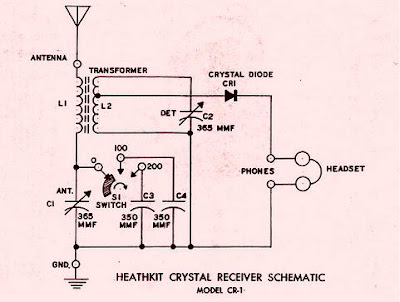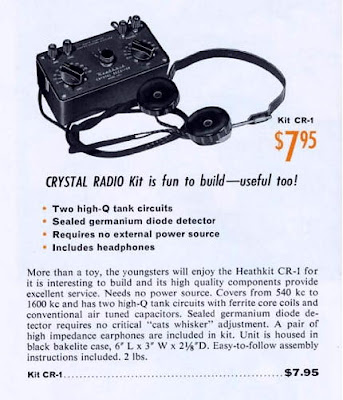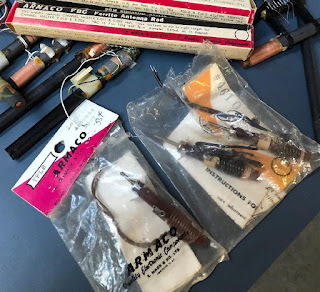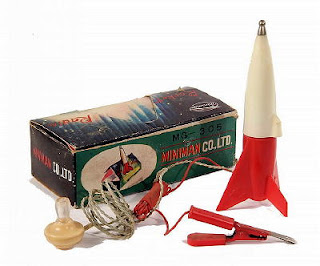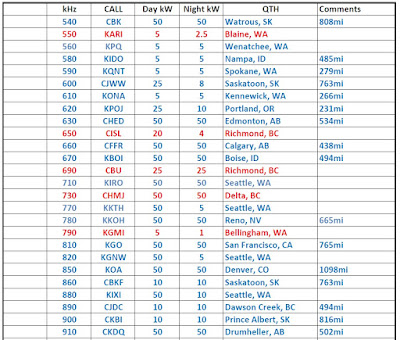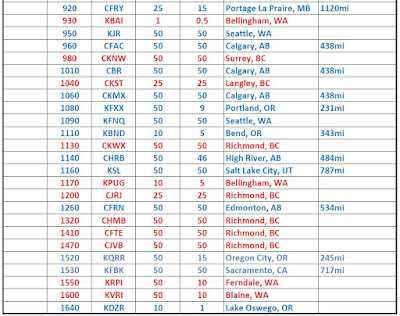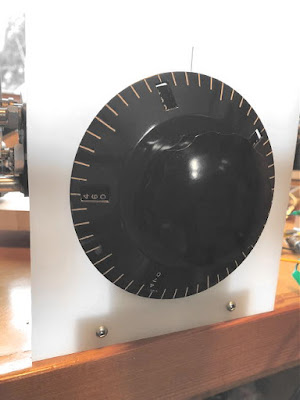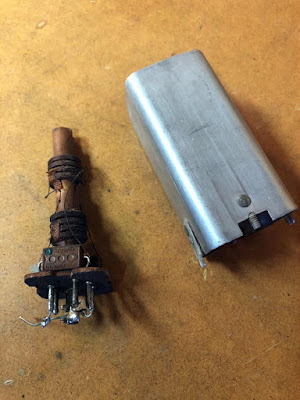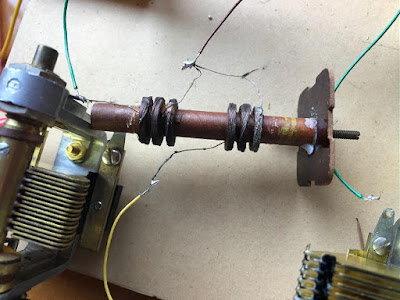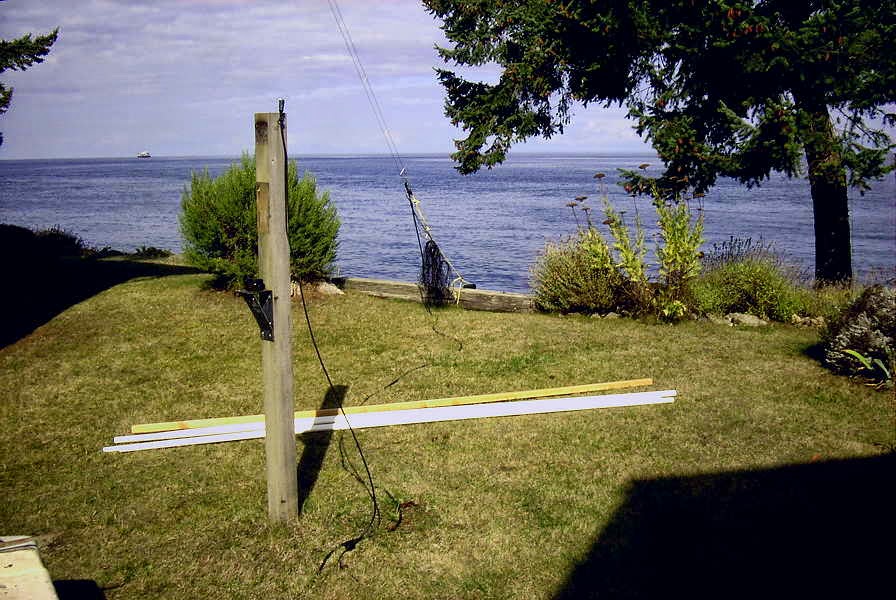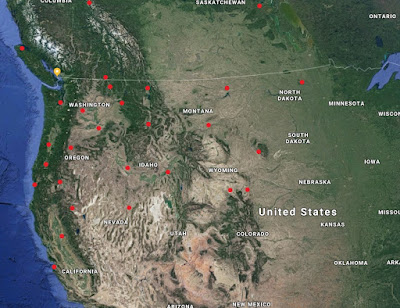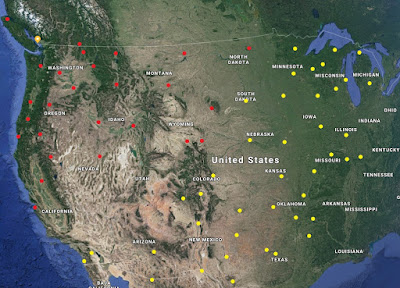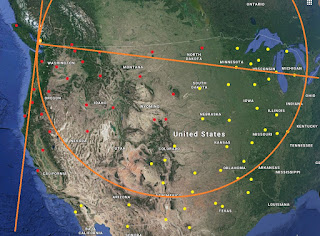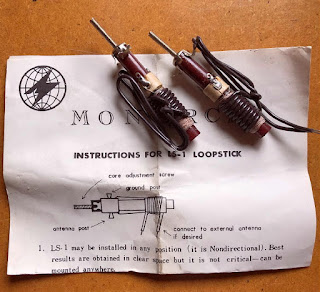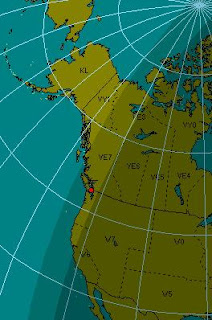Posts Tagged ‘BCB’
 Loopstick Magic And The CR-1 Clone
Loopstick Magic And The CR-1 Clone
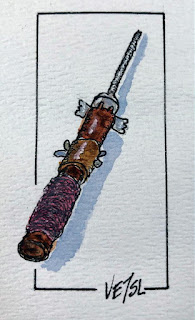 |
| BCB Ferrite Loopstick |
Regular blog readers may recall my two previous blogs, on the Heathkit CR-1 crystal radio receiver.
This very much sought-after radio is a well engineered ‘double-tuned’ set utilizing a series-tuned antenna tank circuit coupled to a parallel-tuned detector tank.
Both coils are wound on the same 1/4” diameter tubular form containing two ferrite slugs ... one for the antenna coil and one for the detector coil. The coils have been pre-wound and fixed on the form, about 20mm apart while the slugs have been waxed in place to set each inductance to the desired value.
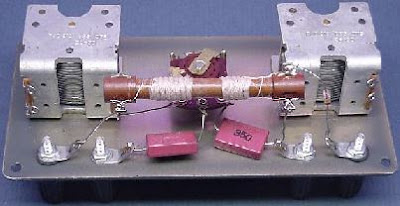 |
| courtesy: Scott's Crystal Radios |
I do wish that I'd had enough sense when I was a kid to buy myself a CR-1 as it seemed like they were dirt-cheap.
The $7.95 even included a set of headphones! Of course, $7.95 to a 12 year old was probably a lot of money, being about $70 in today’s currency!
My previous experience with homebrew DX crystal radios (ones that can hear stations other than strong locals) had taught me that they required large coils and ‘hot’ diodes. The CR-1 has neither of these yet it performed exceptionally well during the few weeks of evening tests a few months ago. I was able to log 50 stations, as described in the earlier blog ... and began to see that, just maybe, requirements may not be as rigid as I had always thought, when it comes to building DX sets!
When I discovered several ‘new-in-the bag’ broadcast band ferrite loopsticks in my junk box, I realized there might be an opportunity to allow me to make something very similar to the CR-1 circuit.
These are the same loopsticks used in the crystal ‘Rocket Radio’ of the 50s or in various transistor radios of the day.
I breadboard-mounted the two loopsticks so that the distance between the antenna coil and the detector coil could be adjusted, allowing some control over coupling and selectivity ... something not available with the stationary CR-1 coils.
Using the same antenna, headphones and external wavetraps, proved once again the excellent performance available from a very small and simple hi-Q coil system ... a DX machine without huge coils and expensive Litz! A total of 51 stations were logged over a two-week period, one more than was heard with the CR-1 and with a few ‘almost’ heards still waiting for one of those really good propagation nights. Having the ability to adjust the coupling was very helpful and made some of the weaker stations a little easier to detect. Stations in RED are local strong signals while those in BLUE are skywave propagated DX signals:
Mounting one of my old HRO 'PN' vernier dials on the main tuning capacitor provided plenty of bandspread, with each dial division corresponding to ~ 2kHz. It was very easy to locate any given frequency within the broadcast band once the dial was calibrated.
Soon after, I ran across a post by Zoltan Pap on Facebook’s ‘Crystal Set Radio Group’, describing his unique use of an old 455kHz I.F. transformer in a crystal tuner. I thought this was a rather brilliant idea and dug out an old I.F. can from the junkbox to see what it might offer.
The old I.F. can had two litz-wound (10 strand) tank coils, fixed in place over two adjustable ferrite slug cores ... in reality, something very similar to the, now very difficult to find, ferrite loopsticks used above.
The two inductors measured out at ~ 700uH - 1.1mH as the slugs were tuned from one end to the other. I was aiming for something close to the inductance used in the two CR-1 tank coils ... approximately 380uH.
A sufficient number of turns were removed from both coils to yield the needed inductance and both coils on the CR-1 breadboard clone were replaced with the old I.F. can coils.
In just a few minutes of tuning through the band, it was very easy to hear and separate all 16 local stations (RED in the above log). A few hours after sunset (on a not-so-good night) yielded quick copy of KPOJ (620kHz) in Portland, Oregon (231 miles) as well as CHED (630kHz) in Edmonton, Alberta (534 miles), demonstrating that even this old 1940's I.F. can could be turned into a crystal radio DX machine!
I don't believe the 'Q' of this pair of coils is very high, compared with the smaller loopstick, as its selectivity appears to drop off above 1000kHz. I'll try separating the form into two halves so that the coupling can be adjusted. The experiment is still under way but if you want to play and can't lay your hands on the pricey loopsticks, old I.F. cans are often much easier to find and probably a lot cheaper.
 Recent BCB Loop DX / Upcoming CLE248
Recent BCB Loop DX / Upcoming CLE248
This past week has seen a welcome return to better band conditions on the lower frequencies.
I’ve had my 10' x 20' loop and Perseus SDR combination running a few overnight recordings on the AM broadcast band ... two mornings pointing at Asia and two overnights looking for domestic signals from the east.
The Asian signals have often been very strong, with many signals reaching S9 or higher. I’ve chosen some of the better ones below. Unlike those situated right on the west coast, my location here on Mayne Island gives me a nice shot towards Japan albeit not directly over the ocean, but close enough, as the path crosses islands to my north and then over northern Vancouver Island.
Looking towards eastern North America is a different story, with an unobstructed ocean view from due north to the south east.
As is often the case with overnight recordings, I did not get nearly enough time to thoroughly check them out but one catch caught my attention. It was from WPTX in Lexington Park, Maryland, on 1690kHz. This station supposedly runs 1kW at night and 10kW during the day but on this night (Sept 16), I heard their top-of-hour ID for three consecutive hours! I wonder if someone ‘forgot’ to switch to nightime power or if conditions were just really good? I have heard them again since with two TOH IDs but much weaker and sounding more like a 1kW station should sound!
JOAK - 594kHz in Shobu, Japan (13:30 UTC Sept 20)
JOUB - 774kHz in Akita, Japan (14:00 UTC Sept 20)
(with English lessons)
HLAZ - 1566kHz in Cheju, South Korea (13:30 UTC Sept 20)
(broadcasting in Japanese in this time slot)
Voice of America (VOA) - 1575kHz in Ban Phachi, Thailand (13:30 UTC Sept 20)
(listen for "This is the Voice of America" ID and then into "Yankee-Doodle-Dandy")
************************
Yes! Another month has passed and it's CLE time once again.
This time the hunting grounds will be: 275 kHz - 425 kHz.
For those unfamiliar with this monthly activity, a 'CLE' is a 'Co-ordinated Listening Event', as NDB DXers around the world focus their listening time on one small slice of the NDB spectrum.
If you've been meaning to participate in CLE, then maybe this weekend is a fine time to try! Lately, we've had a lot of first time submissions so you won't be alone!
As well, if you're trying to learn CW, copying NDBs is perfect practice, as the identifier speed is generally slow and the letters are repeated again every few seconds!
At this time of the season, summer lightning storms should be starting to wane and propagation can often be as good as mid-winter if the lightning cooperates.
When tuning for NDBs, put your receiver in the CW mode and listen for the NDB's CW identifier, repeated every few seconds. Listen for U.S. NDB identifiers approximately 1 kHz higher or lower than the published transmitted frequency since these beacons are modulated with a 1020 Hz tone approximately.
For example, 'AA' near Fargo, ND, transmits on 365 kHz and its upper sideband CW identifier is tuned at 366.025 kHz while its lower sideband CW ident can be tuned at 363.946 kHz. Its USB tone is actually 1025 Hz while its LSB tone is 1054 Hz.
Often, one sideband will be much stronger than the other so if you don't hear the first one, try listening on the other sideband.
Canadian NDBs normally have an USB tone only, usually very close to 400 Hz. They also have a long dash (keydown) following the CW identifier.
All NDBs heard in North America will be listed in the RNA database (updated daily) while those heard in Europe may be found in the REU database. Beacons heard outside of these regions will be found in the RWW database.
From CLE organizer Brian Keyte, G3SIA, comes the details:
Hi all
Our 248th Listening Event just squeezes into the last weekend of this month.
Worth waiting for because it is a 'Special', our fifth 'Channels Challenge'.
It's a simple idea, but one that we always seem to enjoy:
Days: Friday 27 September - Monday 30 September
Times: Start and end at midday, your LOCAL time
Range: 275 kHz - 425 kHz (see below)
Target: Try to log ANY ONE NDB in each channel
The 'channel' means the NDB's nominal (published) frequency.
EITHER 321.0 OR 321.5 kHz would be OK for channel 321, etc.
So it means a possible maximum of 151 loggings in all, though that would
probably be miraculous, even for the best placed of us!
All the NDBs must be 'normal' ones (no DGPS, Amateur, etc.) and
no UNIDs in your main list. Yes, it does include those more
challenging frequencies in the DGPS range.
If you want to add extra interest you could also choose to:
Maximise the number of radio countries you hear or
Maximise the total distance to the NDBs you hear or
Maximise the number of 'midday' loggings - i.e. NDBs logged
within 2 hours of midday by your local winter clock time.
It will be extra tough for North American listeners, with their many 'empty'
channels. Southern Hemisphere and Europe listeners should be more lucky.
Our last 'Channels Challenge' was CLE231 in April 2018.
Please look out for the 'Final Details' a few days before the start.
73
Brian
-------------------------------------------------------------------------
From: Brian Keyte G3SIA (CLE coordinator)
ndbcle'at'gmail.com
-------------------------------------------------------------------------
These listening events serve several purposes. They:
The NDB List Group is a great place to learn more about the 'Art of NDB DXing' or to meet other listeners in your region. There is a lot of good information available there and new members are always very welcome. As well, you can follow the results of other CLE participants from night to night as propagation is always an active topic of discussion.
You need not be an NDB List member to participate in the CLEs and all reports, no matter how small, are of much value to the organizers.
Remember - 'First-time' logs are always VERY welcome!
Reports may be sent to the NDB List Group or e-mailed to CLE co-ordinator, Brian Keyte (G3SIA), whose address appears above. If you are a member of the group, all final results will also be e-mailed and posted there.
Please ... give the CLE a try ... then let us know what NDB's can be heard from your location! Your report can then be added to the worldwide database to help keep it up-to-date.
Have fun and good hunting!
I’ve had my 10' x 20' loop and Perseus SDR combination running a few overnight recordings on the AM broadcast band ... two mornings pointing at Asia and two overnights looking for domestic signals from the east.
The Asian signals have often been very strong, with many signals reaching S9 or higher. I’ve chosen some of the better ones below. Unlike those situated right on the west coast, my location here on Mayne Island gives me a nice shot towards Japan albeit not directly over the ocean, but close enough, as the path crosses islands to my north and then over northern Vancouver Island.
Looking towards eastern North America is a different story, with an unobstructed ocean view from due north to the south east.
As is often the case with overnight recordings, I did not get nearly enough time to thoroughly check them out but one catch caught my attention. It was from WPTX in Lexington Park, Maryland, on 1690kHz. This station supposedly runs 1kW at night and 10kW during the day but on this night (Sept 16), I heard their top-of-hour ID for three consecutive hours! I wonder if someone ‘forgot’ to switch to nightime power or if conditions were just really good? I have heard them again since with two TOH IDs but much weaker and sounding more like a 1kW station should sound!
JOAK - 594kHz in Shobu, Japan (13:30 UTC Sept 20)
JOUB - 774kHz in Akita, Japan (14:00 UTC Sept 20)
(with English lessons)
HLAZ - 1566kHz in Cheju, South Korea (13:30 UTC Sept 20)
(broadcasting in Japanese in this time slot)
Voice of America (VOA) - 1575kHz in Ban Phachi, Thailand (13:30 UTC Sept 20)
(listen for "This is the Voice of America" ID and then into "Yankee-Doodle-Dandy")
************************
Hunting For NDBs In CLE248
Yes! Another month has passed and it's CLE time once again.
This time the hunting grounds will be: 275 kHz - 425 kHz.
For those unfamiliar with this monthly activity, a 'CLE' is a 'Co-ordinated Listening Event', as NDB DXers around the world focus their listening time on one small slice of the NDB spectrum.
If you've been meaning to participate in CLE, then maybe this weekend is a fine time to try! Lately, we've had a lot of first time submissions so you won't be alone!
As well, if you're trying to learn CW, copying NDBs is perfect practice, as the identifier speed is generally slow and the letters are repeated again every few seconds!
At this time of the season, summer lightning storms should be starting to wane and propagation can often be as good as mid-winter if the lightning cooperates.
When tuning for NDBs, put your receiver in the CW mode and listen for the NDB's CW identifier, repeated every few seconds. Listen for U.S. NDB identifiers approximately 1 kHz higher or lower than the published transmitted frequency since these beacons are modulated with a 1020 Hz tone approximately.
For example, 'AA' near Fargo, ND, transmits on 365 kHz and its upper sideband CW identifier is tuned at 366.025 kHz while its lower sideband CW ident can be tuned at 363.946 kHz. Its USB tone is actually 1025 Hz while its LSB tone is 1054 Hz.
Often, one sideband will be much stronger than the other so if you don't hear the first one, try listening on the other sideband.
Canadian NDBs normally have an USB tone only, usually very close to 400 Hz. They also have a long dash (keydown) following the CW identifier.
All NDBs heard in North America will be listed in the RNA database (updated daily) while those heard in Europe may be found in the REU database. Beacons heard outside of these regions will be found in the RWW database.
From CLE organizer Brian Keyte, G3SIA, comes the details:
Hi all
Our 248th Listening Event just squeezes into the last weekend of this month.
Worth waiting for because it is a 'Special', our fifth 'Channels Challenge'.
It's a simple idea, but one that we always seem to enjoy:
Days: Friday 27 September - Monday 30 September
Times: Start and end at midday, your LOCAL time
Range: 275 kHz - 425 kHz (see below)
Target: Try to log ANY ONE NDB in each channel
The 'channel' means the NDB's nominal (published) frequency.
EITHER 321.0 OR 321.5 kHz would be OK for channel 321, etc.
So it means a possible maximum of 151 loggings in all, though that would
probably be miraculous, even for the best placed of us!
All the NDBs must be 'normal' ones (no DGPS, Amateur, etc.) and
no UNIDs in your main list. Yes, it does include those more
challenging frequencies in the DGPS range.
If you want to add extra interest you could also choose to:
Maximise the number of radio countries you hear or
Maximise the total distance to the NDBs you hear or
Maximise the number of 'midday' loggings - i.e. NDBs logged
within 2 hours of midday by your local winter clock time.
It will be extra tough for North American listeners, with their many 'empty'
channels. Southern Hemisphere and Europe listeners should be more lucky.
Our last 'Channels Challenge' was CLE231 in April 2018.
Please look out for the 'Final Details' a few days before the start.
73
Brian
-------------------------------------------------------------------------
From: Brian Keyte G3SIA (CLE coordinator)
ndbcle'at'gmail.com
-------------------------------------------------------------------------
These listening events serve several purposes. They:
- determine, worldwide, which beacons are actually in service and on-the-air so the online database can be kept up-to-date
- determine, worldwide, which beacons are out-of-service or have gone silent since the last CLE covering this range
- will indicate the state of propagation conditions at the various participant locations
- will give you an indication of how well your LF/MF receiving system is working
- give participants a fun yet challenging activity to keep their listening skills honed
The NDB List Group is a great place to learn more about the 'Art of NDB DXing' or to meet other listeners in your region. There is a lot of good information available there and new members are always very welcome. As well, you can follow the results of other CLE participants from night to night as propagation is always an active topic of discussion.
You need not be an NDB List member to participate in the CLEs and all reports, no matter how small, are of much value to the organizers.
Remember - 'First-time' logs are always VERY welcome!
Reports may be sent to the NDB List Group or e-mailed to CLE co-ordinator, Brian Keyte (G3SIA), whose address appears above. If you are a member of the group, all final results will also be e-mailed and posted there.
Please ... give the CLE a try ... then let us know what NDB's can be heard from your location! Your report can then be added to the worldwide database to help keep it up-to-date.
Have fun and good hunting!
 My 10’ x 20’ Active Loop
My 10’ x 20’ Active Loop
 |
| courtesy: americanradiohistory.com |
After recently installing a new coax run out to the loop and after five years of summer sunlight, the plastic food-storage container used to house the loop’s preamp (Wellbrook ALA100LN ... LF-30MHz) finally bit the dust ... literally.
Last week I replaced the housing with a slightly larger plastic box but I’ll still be faced with the UV bombardment and eventual deterioration of the clear plastic and lid unless I do something different.
I’ve a couple of thoughts but am hoping for some other suggestions from blog readers.
I have thought about spray painting the container, which may (or may not) prevent UV damage, but wonder if paint will stick to the smooth plastic surface? Maybe if scuffed-up a bit it would stick ... if so, the coating could be annually renewed.
Another idea is to cover it with duct tape ... not pretty, but possibly doing the job. Any other thoughts out there?
Part 2 and Part 3 of this blog were originally published when the loop was first built (2014) and describe the antenna details as well as showing the loop in action ... listening on the NDB and broadcast band as well as showing its nulling capability. It’s been a great performer and I can highly recommend the ALA100LN for a large aperture receiving loop. I’m looking forward to what will hopefully be a good winter of exciting loop DXing.
Part 2 - New LF / MF Loop
Some may recall my blog back in July (Wellbrook Loop Plans) describing a new loop that I had been thinking about as a possible replacement for my 10' shielded loop. I had been doodling various construction ideas using PVC tubing in an effort to keep it as light as possible, without introducing any metal near the loop. On Monday of this week, I dismantled the 10' loop in preparation for my new experimental rectangular loop.
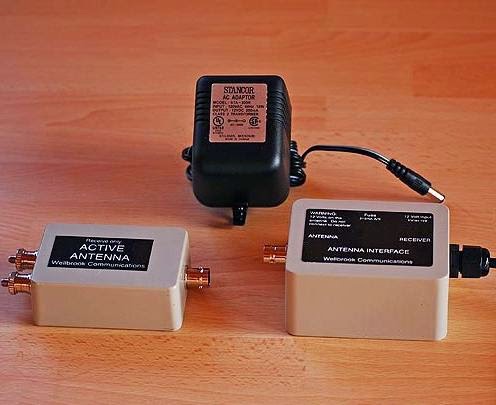 I've had the Wellbrook loop preamp here for a few months, so it was now or never, while the weather was still 'antenna-friendly'. Now I do understand that this goes against one of ham radio's long-standing traditions that dictates all antenna work must wait until the weather can't get any worse. Antennas built in the winter rain always work much better than ones put up in the summer. Hopefully it's not Wouff-Hong or Rettysnitch punishable but the fall DX season is almost upon us and I'm not waiting for the rain!
I've had the Wellbrook loop preamp here for a few months, so it was now or never, while the weather was still 'antenna-friendly'. Now I do understand that this goes against one of ham radio's long-standing traditions that dictates all antenna work must wait until the weather can't get any worse. Antennas built in the winter rain always work much better than ones put up in the summer. Hopefully it's not Wouff-Hong or Rettysnitch punishable but the fall DX season is almost upon us and I'm not waiting for the rain!The new 'loop' is not really loop-shaped but is rectangular (10' x 20') and more like a Flag antenna shape. I considered a Flag but really don't need any back-end nulling capability since I'm mainly interested in listening to the east and to the north.
The main boom section is composed of two sections of 1" PVC thick-wall (Schedule 40) pipe joined at the center and reinforced with a 10' section of 2" x 2" Douglas Fir. In addition, the boom has a truss of 1/4" Dacron to take out any end-loading sag. The vertical end sections are 3/4" Schedule 40 PVC pipe, fastened with a T at the boom end. The center mast is made of 2" Schedule 40 ABS pipe with a long section of 1 1/2" ABS nested inside that telescopes upward to anchor the truss ropes and give some additional rigidity to the mast.
 |
| Main boom and mast construction |
 |
| Looping E/W |
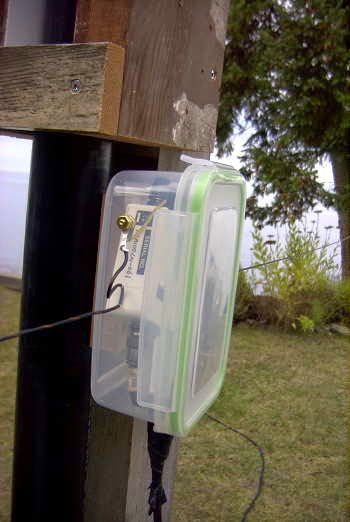
Although the preamp is completely sealed and weatherproofed, I still decided to mount it inside a container. The container also provided a convenient anchor to terminate the loop end wires (PVC-coated #18 stranded) without putting any tension on the soldered terminals.
Although I have not had much time to listen, and conditions are still in 'recovery' mode from earlier disturbances, initial indications are that everything is performing as well, if not better, than expected. It certainly outperforms my 10' active shielded loop by a large margin. I have yet to do any serious S/N comparisons between it and my primary LF receive antenna, a large inverted L, which must be tuned to resonance for the desired listening range. I believe that the very quiet loop / Wellbrook combination will provide an overall S/N improvement.
I have always believed that smaller loops provide deeper and sharper front-to-side nulls so I was pleasantly surprised to measure (using Perseus) null depths from 25-30db, on various groundwave signals ... more than expected. Skywave signals also deliver sharp deep nulls in the order of 22 - 25db ... again surprising, but I'll take them!
A brief listen while pointing S-E last evening turned up good signals from 1 kW'ers KYHN (1650kHz) in Fort Smith, Arkansas and KKGM (1630kHz) in Fort Worth, Texas. An early morning listen revealed good audio from JOIK (567kHz) Sapporo, Japan and JOAK (595kHz) in Shobu. Down in the ndb band, little 25-watter 'IP' on 210kHz was an all-time new catch from Mobile, Arizona.
There is still much to learn from this new antenna system but the biggest challenge will be keeping it up all winter. I did lose one of my 10' loops after several years, due to wind, when the main (un-reinforced) PVC mast eventually failed from flexing fatigue. I will tie the ends of the new antenna down when the winds get strong to reduce as much mast flexing as possible. I could however, run the risk of violating another long-standing radio adage ..."if your antenna stays up all winter, it's not big enough". I just can't win.
Part 3 - Loop Listen
As Murphy would have it, and in spite of the low amount of solar activity, LF/MF propagation has been very poor since getting my new 10' x 20' loop in place. The few front-to-side nulling checks that I have done, have produced results varying from around 20db to 30db, depending upon the signal. I suspect the depth of null is also affected by the signal's arrival angle but there is still more to learn. The pattern seems to be very close to that of a typical circular loop...the classic figure-8 pattern illustrated below as shown on the Wellbrook data that came with my ALA100LN preamp.
 |
| Courtesy: http://www.wellbrook.uk.com |
More typically, the null is around 21-22 db as shown on this test while listening to the ground wave carrier of the 'YZA' NDB (236kHz) located in Ashcroft, B.C., about 150 miles to the NE. As expected, the null is fairly sharp and the front / rear lobe, fairly broad.
One short check at dusk produced nice signals from CJBC, the French-language station in Toronto. The past few nights it has been very strong but with a strong echo effect. I wonder if there is more than one CBC outlet here (860kHz), such as a low-power repeater, causing the echo.
At the same time, while still fairly light outside, WCCO in Minneapolis had a nice signal just before sunset.
No matter how poor conditions become, it seems that the Hinchinbrook (Alaska) NDB, 'ALJ' (233kHz), is always strong ... looping north.
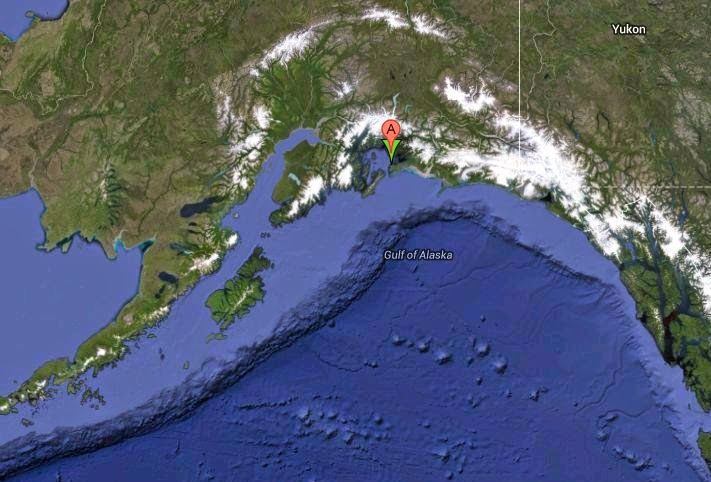 |
| Courtesy: https://www.google.ca/maps |
(Since originally posting the above, I have been using the Tiny Take free screen capturing software, to produce better quality catures of my Perseus recordings. It's also probable that my new iPhone would produce a high quality video of my computer screen compared to the older iPad used for these ones, but it's something yet to be tried.)
Hopefully conditions will only get better as the season progresses and I am able to give the loop a good workout ... before it gets too windy!
 A Long Listen On 1240 KHz
A Long Listen On 1240 KHz
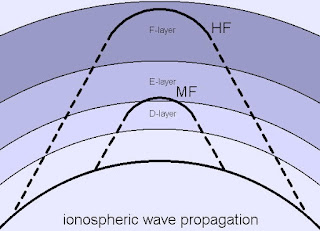 |
| Ionosphere: source |
One of the Broadcast Band’s (BCB) six ‘graveyard’ frequencies is 1240 KHz.
These frequencies (1230, 1240, 1340, 1400, 1450 and 1490 KHz) are assigned to smaller stations running non-directional antennas and up to 1000 watts of power. In North America, there are typically about 150 stations assigned to each frequency.
The origin of this spooky name is often a source of debate. Some suggest that it comes from the cacophony of strange howls and sounds that can be heard on these frequencies at night, as multiple fading signals fight it out to be heard, while others relate it to the similarity of the jam-packed headstones in a typical graveyard. Whatever the true reason, it's a fascinating part of the BCB to explore.
Most BCB DXers enjoy the challenge of tackling the graveyard frequencies as they're often so busy. New stations will fade in for a brief period only to be replaced by a totally different one a few moments later ... and then a different one soon after. It gets even better if the fade-ups coincide with a local ad or a ‘top-of-hour’ ID, putting a new catch in the log!
Several days ago I reactivated my 10’ x 20’ loop and Wellbrook ALA100N preamp, that I use for NDB and BCB DXing, by adding a new buried coax line from the shack.
I had previously re-appropriated the loop’s coax for a nearby HF wire antenna and had been without the loop all winter.
After BCB DXer Mike Cherry (VE7SKA) on Salt Spring Island, the next island to the west of me, described some of the European action that he had experienced last winter, I am determined to not miss out during the next winter's BCB DX season!
 |
| 10' x 20' Loop & Wellbrook ALA100N Preamp |
Once getting the loop powered-up in mid-afternoon, I decided to give it a test by making a ‘deep-search’ on 1240 KHz.
At 1500 hours local time, I wasn’t hearing any audio on 1240 but a weak carrier could be detected audibly. Using my Perseus SDR’s waterfall in its narrowest possible window, produces an extremely narrow passband, effectively increasing the sensitivity by a huge factor. This allows the waterfall to display weak signals that are presently being propagated to my location but far too weak to be heard by ear. I’m estimating that in this narrow bandwidth, it can dig about 30 dB or more into the noise, but there is a price to be paid for this extra gain .... time!
If you're used to watching your receiver’s waterfall scroll along quickly, this mode is just the opposite. It moves in very slow increments, allowing the weaker signals to build up enough to be visible before taking the next deep look. The screen capture shown below is a result of a three-hour listening period, from 1500-1800 hours local time. The entire waterfall is 25 Hz wide, with each tick representing 1Hz.
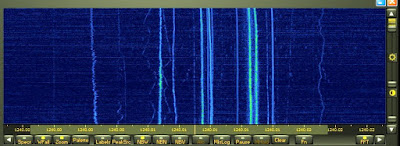 |
| 3-Hour Daylight Deep Search |
Although no signals were clearly audible during this period, my deep-search revealed the carriers of ~28 different stations being received here in south-west British Columbia ... in the middle of a summer afternoon! It’s interesting to note that few of these signals are 100% stable and several can be seen really struggling to maintain their exact assigned frequency. In this highly narrow bandwidth view, even the worst drift amounts to no more than a Hertz, well within the required tolerance of +/- 20Hz.
Using the always-reliable MWLIST, the locations of the most likely candidates for these 28 signals are plotted below. These are the 28 nearest stations and with my loop pointing east, a definite east / south-east flavour is evident.
At mid afternoon, one might expect to see only groundwave-propagated signals on the broadcast band. Midday groundwave on the broadcast band can easily travel a few hundred kilometers, gradually growing weaker over the longer paths. Perhaps all of these signals are arriving via this mode as they are at least 20-30dB into the noise. I initially thought that some of the further-out signals were being reflected from a strong daytime D-layer, although most of the energy would be absorbed. Further reading shows detectable groundwave up to 1200km is possible which coincides nicely with the distances observed. Most likely what I'm seeing is a combination of extended groundwave and D-layer refraction on the furthest signals.
The second screen capture shows the same frequency for another three hours, starting about an hour before local sunset. Some of the weaker signals seen earlier now begin to grow in strength as the D-later absorption starts to decay and reveal the higher E-layer. By the end of the third hour, an additional 41 stations have appeared for a total of 69 carriers cantered on 1240 KHz. (note that my Perseus calibration is off by a few Hz)
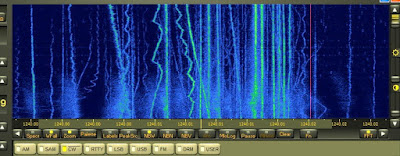 |
| 3-Hour Sunset Deep Search |
The next 41 closest stations are now plotted below in yellow, showing the most likely source of these signals. The distances illustrated are in-line with single and double-hop E-layer or possibly lower F-layer refraction.
This view shows the directional pattern of the front of the loop while pointing east, with its very broad circular lobe. In this direction, the narrow null is only seen along the coast.
It will be interesting to do a mid-winter follow-up on 1240 and compare the present summer propagation to the much better winter conditions. I expect that a some point, propagation via the higher F-layer will be present and extend skip distances out to the east coast or to South America.
In the meantime, things are almost ready for some pre-sunrise looks to the west and some overnight top-of-hour recordings ... as soon as I re-calibrate Perseus!
 The Enigmatic Heathkit CR-1 Crystal Radio
The Enigmatic Heathkit CR-1 Crystal Radio
For the past several months my interest in ‘DX-crystal radio’ construction has been percolating once again. It began when I ran across an interesting description of Heathkit’s legendary CR-1, a double-tuned good performer and very much sought-after by collectors as well as by users. The article described one homebrewer’s attempt to duplicate the receiver and to learn more about the detector and antenna tuning ferrite-loaded coil's secrets.

When it comes to crystal radios, there is nothing revolutionary regarding the CR-1’s basic circuitry but for some odd reason, it has achieved cult-like status as well as high dollar value.
I've been eager to get my mitts on one to see how it performs after reading of one DXer's fifty-eighth catch with his own CR-1!
The article that piqued my interest appears on 'Scott's Crystal Radios' website and makes for an inspirational read, eventually revealing the inside core arrangement of the ferrite-loaded tuned circuits via an actual X-ray of the device! By the way, if you are looking for a nice set of older headphones, Scott's website is the place to visit!
Scott was eventually able to achieve performance equal to that of his borrowed CR-1, with his own slightly modified versions, all in a similar-sized footprint. Perhaps this is one reason why the CR-1 is so much sought-after, as good performance in a very small package is not the norm when it comes to crystal radios. It's usually a case of ‘the bigger, the better’ when it comes to performance.
A recent search of my junque box revealed several NIB ferrite loopsticks that would allow a potntial reproduction of this interesting circuit.
Several years ago I spent an eye-opening winter learning about DX crystal radios as up to that time I had always believed it would be impossible to hear anything other than strong local signals on a crystal radio. I quickly discovered that there was a very large Crystal Radio Yahoo Group where menbers were working at the leading edge of crystal radio design. I also found that the group sponsored an annual Crystal Radio DX Contest which inspired me to dig deeper.
It wasn’t too long before I decided to join the fun and attempt to build a crystal radio DX-machine but I was in for a few surprises and a long learning curve ... it seemed that hearing broadcast band ‘DX’ on a crystal radio (anything other than loud locals) was not going to be an easy task!
Over the course of several months I tried many types of variable capacitors, tank coil configurations and antenna tuning circuits. I even erected a dedicated antenna system for the various experimental circuits I was putting together ... an 'Inverted-L', 50’ straight up and 70’ horizontal, along with a ground rod connected to several buried radials.
I quickly learned about something I normally didn’t have to worry about when working with ‘active’ devices and that was overcoming system and component losses. In critical crystal radio design, it’s all about minimizing the losses in every stage and every component in the system since there are no amplifiers to help overcome these losses. Your system is only as good as the weakest link. In true crystal radio DXing, no active devices are permitted ... it’s just your crystal radio and the energy generated at some, hopefully far away, transmitter site!
After several months, I eventually ended up with a well-performing triple-tuned set that used lots of 'trapping' because of all of the very strong nearby signals here ... eight 50kW locals!
A description of the learning curve, with several do's and dont's to help new builders, can be found on my website here.
Back then, 80 stations were logged (from my location on Mayne Island in SW British Columbia) over the one-week Crystal Radio DX Contest.
CRYSTAL RADIO LOGBOOK
Old notes indicate that there were 14 stations at S9 or higher, requiring heavy trapping to hear anything close to their frequencies.

When it comes to crystal radios, there is nothing revolutionary regarding the CR-1’s basic circuitry but for some odd reason, it has achieved cult-like status as well as high dollar value.
 |
| courtesy: Scotts Crystal Radios |
The article that piqued my interest appears on 'Scott's Crystal Radios' website and makes for an inspirational read, eventually revealing the inside core arrangement of the ferrite-loaded tuned circuits via an actual X-ray of the device! By the way, if you are looking for a nice set of older headphones, Scott's website is the place to visit!
 |
| courtesy: Scott's Crystal Radios |
Scott was eventually able to achieve performance equal to that of his borrowed CR-1, with his own slightly modified versions, all in a similar-sized footprint. Perhaps this is one reason why the CR-1 is so much sought-after, as good performance in a very small package is not the norm when it comes to crystal radios. It's usually a case of ‘the bigger, the better’ when it comes to performance.
A recent search of my junque box revealed several NIB ferrite loopsticks that would allow a potntial reproduction of this interesting circuit.
Several years ago I spent an eye-opening winter learning about DX crystal radios as up to that time I had always believed it would be impossible to hear anything other than strong local signals on a crystal radio. I quickly discovered that there was a very large Crystal Radio Yahoo Group where menbers were working at the leading edge of crystal radio design. I also found that the group sponsored an annual Crystal Radio DX Contest which inspired me to dig deeper.
It wasn’t too long before I decided to join the fun and attempt to build a crystal radio DX-machine but I was in for a few surprises and a long learning curve ... it seemed that hearing broadcast band ‘DX’ on a crystal radio (anything other than loud locals) was not going to be an easy task!
Over the course of several months I tried many types of variable capacitors, tank coil configurations and antenna tuning circuits. I even erected a dedicated antenna system for the various experimental circuits I was putting together ... an 'Inverted-L', 50’ straight up and 70’ horizontal, along with a ground rod connected to several buried radials.
I quickly learned about something I normally didn’t have to worry about when working with ‘active’ devices and that was overcoming system and component losses. In critical crystal radio design, it’s all about minimizing the losses in every stage and every component in the system since there are no amplifiers to help overcome these losses. Your system is only as good as the weakest link. In true crystal radio DXing, no active devices are permitted ... it’s just your crystal radio and the energy generated at some, hopefully far away, transmitter site!
After several months, I eventually ended up with a well-performing triple-tuned set that used lots of 'trapping' because of all of the very strong nearby signals here ... eight 50kW locals!
A description of the learning curve, with several do's and dont's to help new builders, can be found on my website here.
Back then, 80 stations were logged (from my location on Mayne Island in SW British Columbia) over the one-week Crystal Radio DX Contest.
FRQ | STATION | LOCATION | POWER |
540 | CBK | WATROUS, SK | 50KW |
550 | KARI | BLAINE, WA | 2.5KW |
560 | KPQ | WENATCHEE, WA | 5KW |
570 | KVI | SEATTLE, WA | 5KW |
580 | KFXD | NAMPA, ID | 5KW |
580 | KTMT | ASHLAND, OR | 1KW |
600 | CKBD | VANCOUVER, BC | 10KW |
650 | CISL | VANCOUVER, BC | 10KW |
670 | KBOI | BOISE, ID | 50KW |
690 | CBU | VANCOUVER, BC | 50KW |
730 | CJNW | VANCOUVER, BC | 50KW |
750 | KXL | PORTLAND, OR | 20KW |
770 | CHQR | CALGARY, AB | 50KW |
780 | KKOH | RENO, NV | 50KW |
790 | KGMI | BELLINGHAM, WA | 1KW |
800 | CKOR | PENTICTON, BC | 500W |
800 | CHAB | MOOSEJAW, SK | 10KW |
810 | KGO | SAN FRANCISCO, CA | 50KW |
820 | KGNW | SEATTLE, WA | 5KW |
830 | CKKY | WAINRIGHT, AB | 3.5KW |
840 | KSWB | SEASIDE, OR | 500W |
840 | CKBX | 100 MILE HOUSE, BC | 500W |
850 | KOA | DENVER, CO | 50KW |
860 | KPAM | TROUTDALE, OR | 10KW |
870 | KFLD | PASCO, WA | 250W |
880 | KIXI | MERCER ISLAND, WA | 10KW |
880 | COOL | EDMONTON, AB | 50KW |
890 | CJDC | DAWSON CREEK, BC | 10KW |
900 | CKMO | VICTORIA, BC | 10KW |
910 | CKDQ | DRUMHELLER, AB | 50KW |
920 | KXLY | SPOKANE, WA | 5KW |
930 | KBAI | BELLINGHAM, WA | 500W |
940 | CJGX | YORKTON, SK | 50KW |
950 | KJR | SEATTLE, WA | 50KW |
960 | CFAC | CALGARY, AB | 50KW |
980 | CKNW | NEW WESTMINSTER, BC | 50KW |
1010 | CBR | CALGARY, AB | 50KW |
1040 | CKST | VANCOUVER, BC | 50KW |
1060 | CKMX | CALGARY, AB | 50KW |
1070 | CFAX | VICTORIA, BC | 10KW |
1090 | KYCW | SEATTLE, WA | 50KW |
1130 | CKWX | VANCOUVER, BC | 50KW |
1160 | KSL | SALT LAKE CITY, UT | 50KW |
1170 | KPUG | BELLINGHAM, WA | 5KW |
1180 | KOFI | KALISPELL, MT | 10KW |
1190 | KEX | PORTLAND, OR | 50KW |
1200 | WOAI | SAN ANTONIO, TX | 50KW |
1210 | KBSG | AUBURN, WA, | 10KW |
1210 | KZTS | SUNNYSIDE, WA | 1KW |
1240 | KGY | OLYMPIA, WA | 1KW |
1240 | KOFE | ST. MARIES, ID | 500W |
1250 | KKDZ | SEATTLE, WA | 5KW |
1250 | KWSU | PULLMAN, WA | 5KW |
1260 | CFRN | EDMONTON, AB | 50KW |
1260 | KLYC | McMINVILLE, OR | 850W |
1270 | CHAT | MEDICINE HAT, AB | 10KW |
1270 | KTFI | TWIN FALLS, ID | 1KW |
1280 | KIT | YAKIMA, WA | 1KW |
1290 | KGVO | MISSOULA, MT | 5KW |
1290 | KUMA | PENDLETON, OR | 5KW |
1290 | KKSL | LAKE OSWEGO, OR | 5KW |
1300 | KOL | SEATTLE, WA | 5KW |
1300 | CJME | REGINA, SK | 10KW |
1310 | CHLW | ST. PAUL, AB | 10KW |
1320 | CHMB | VANCOUVER, BC | 50KW |
1340 | KLKI | ANACORTES, WA | 1KW |
1360 | KKMO | TACOMA, WA | 5KW |
1370 | KAST | ASTORIA, OR | 1KW |
1410 | CFUN | VANCOUVER, BC | 50KW |
1470 | CJVB | VANCOUVER, BC | 50KW |
1510 | KGA | SPOKANE, WA | 50KW |
1520 | KKSN | OREGON CITY, OR | 15KW |
1530 | KFBK | SACRAMENTO, CA | 50KW |
1550 | KCCF | FERNDALE, WA | 10KW |
1590 | KLIV | SAN JOSE, CA | 5KW |
1600 | KVRI | BLAINE, WA | 10KW |
1620 | KYIZ | RENTON, WA | 1KW |
1640 | KPBC | LAKE OSWEGO, OR | 1KW |
1660 | KXOL | BRIGHAM CITY, UT | 1KW |
Old notes indicate that there were 14 stations at S9 or higher, requiring heavy trapping to hear anything close to their frequencies.
| My recent interest made me wonder what the situation is today when it comes to the number of strong local ‘blowtorch’ signals, surely the bane of all crystal radio DXers? Although there have been a few changes over the years, a quick scan of the band during the prime DX evening hours found that although one of the blowtorch signals (at 600kHz) was now gone, another had appeared at 1200kHz ... sadly no net difference. The top end of the band, always a prime area for good skywave DX, is unfortunately still dominated by a huge signal from KVRI just across the water near the Canadian / U.S. border. If KVRI were silent, the top end would be a wonderfully quiet hunting-ground for new catches. The new local blowtorch (CJRJ) on 1200 kHz will now cause problems for the middle of the band, which was always a good region for DX. So it seems overall, there hasn’t been a huge change here other than in the middle of the band. It looks as though there are still some good watering-holes to be had but several traps will still be needed in any new system. Once my present radio-bench project is finished (a '36 RK-39 crystal power oscillator) I’m looking forward to more research and design of a couple of new systems, starting with something similar to the CR-1 as well as some experimentation with toroidal coils. I always find the research and planning phase of any new project more interesting and fulfilling than the actual construction and implementation! Hopefully I’ll have something ready for the fall DX season! Thanks to VA7MM, I will also have the loan of an original CR-1 next winter to make comparisons to any clone that I might build! If building a DX-crystal radio is something that might interest you, there are several great websites offering inspiration and helpful info. The links for these may be found at the bottom of my own crystal radio page. As well, there are two active crystal radio groups on Facebook, where daily two-way discussion can be had. Perhaps, with enough new interest, we can even revive the annual Crystal Radio DX Contest! |
 TIS DX
TIS DX
 Have you ever wondered where those odd stations found at the ends of the AM broadcast band might be located and what they're all about? These are 'Traveller Information Stations' or 'TIS's and, 'Highway Advisory Radio' (HAR) stations. Because of their low power (100mw - 10W), they make challenging DX targets if you can catch the ID on their continually- repeated audio loop.
Have you ever wondered where those odd stations found at the ends of the AM broadcast band might be located and what they're all about? These are 'Traveller Information Stations' or 'TIS's and, 'Highway Advisory Radio' (HAR) stations. Because of their low power (100mw - 10W), they make challenging DX targets if you can catch the ID on their continually- repeated audio loop.These stations are located throughout Canada and the USA at places such as highway intersections, border crossings, ferry terminals, airports and parks ... just about any place that needs to advise travellers (vehicles) with up-to-date directions or information. From here on Mayne Island, the farthest TIS I have been able to identify was WPTC509, located in Carbon County, Wyoming.
 |
| courtesy: https://www.google.ca/maps |
IRCA TIS/HAR LIST (Winter 2016)
The IRCA TIS/HAR LIST lists all US and Canadian TIS/HAR stations, by frequency, including call letters, state (province,) city, county, licensee, address, coordinates, expiration date and dates of DXM/DXN reports/sources. It has been updated with FCC data, DXM, DXN and DXer reports, and on-line listings through March 1 2016.
The 2016 IRCA TIS/HAR LIST is posted on the IRCA website for all to download. The link is: http://www.ircaonline.org/TIS_2016.pdf.
For those preferring a hard copy, one can be ordered from the IRCA.
As well, this page on regulations, permitted content and TIS history has some interesting info.
IRCA is one of the oldest clubs dedicated to DXing the broadcast bands and members receive a monthly journal of members loggings as well as other relevant articles. A trip to the IRCA website might get you hooked on this part of the radio hobby as it's probably the way that most amateurs discovered the 'magic of radio', on late winter nights! Just in case you need it, the mwlist will help you identify any stations heard in the AM broadcast band, worldwide.
 Conditions Rising
Conditions Rising
Conditions towards the east on LF as well as on the broadcast band (BCB) have taken a positive leap forward over the past few days. Last night, 160m was open to Europe from here, the first opening of the season as far as I am aware. I also spent some time listening to a dozen or more TA (Trans-Atlantic) carriers on the broadcast band, signalling good conditions over the pole finally.The polar skip also extended down into the LF band, as it did the previous night.
In the afternoon hours I started watching for Europe1 on 183kHz, transmitting from western Germany, and was able to see its weak carrier on the Perseus SDR's waterfall display several hours before sunset. Twilight here brought a dramatic improvement in signal strength as shown below.
As daylight approached the transmitter site in Germany, the 183kHz signal provided a good visual example of 'dawn-enhancement', with the signal showing a dramatic flare on the waterfall indicating its build-up in strength.
Once dawn arrived, it was interesting to see that the signal was able to hang-on for over an hour with reasonable strength before fading out rather quickly. Even though the transmitter site was in full daylight, the dark skies to the west were able to sustain propagation for some time before it all came crashing down.
Of late, the pre-dawn hours here have also been providing some exceptionally strong signals from Asia on the BCB. These are often enhanced at sunrise as well, as the strength often takes a short fast peak, before fading out for the day.
One of the loudest this week was from JOAK (NHK1) in Tokyo on 594 kHz ... listen ...
This was heard on the Perseus SDR and inverted-L antenna. The LF polar signals shown above, were recorded with the 10' X 20' loop and Wellbrook preamp while looping towards Europe at 030 degrees.
With the DST going positive, hopefully these good conditions will continue to build over the next few weeks. October is often one of the best months of the year for LF/MF DX.
In the afternoon hours I started watching for Europe1 on 183kHz, transmitting from western Germany, and was able to see its weak carrier on the Perseus SDR's waterfall display several hours before sunset. Twilight here brought a dramatic improvement in signal strength as shown below.
As daylight approached the transmitter site in Germany, the 183kHz signal provided a good visual example of 'dawn-enhancement', with the signal showing a dramatic flare on the waterfall indicating its build-up in strength.
Once dawn arrived, it was interesting to see that the signal was able to hang-on for over an hour with reasonable strength before fading out rather quickly. Even though the transmitter site was in full daylight, the dark skies to the west were able to sustain propagation for some time before it all came crashing down.
Of late, the pre-dawn hours here have also been providing some exceptionally strong signals from Asia on the BCB. These are often enhanced at sunrise as well, as the strength often takes a short fast peak, before fading out for the day.
One of the loudest this week was from JOAK (NHK1) in Tokyo on 594 kHz ... listen ...
This was heard on the Perseus SDR and inverted-L antenna. The LF polar signals shown above, were recorded with the 10' X 20' loop and Wellbrook preamp while looping towards Europe at 030 degrees.
With the DST going positive, hopefully these good conditions will continue to build over the next few weeks. October is often one of the best months of the year for LF/MF DX.
 |
| courtesy: http://wdc.kugi.kyoto-u.ac.jp/dst_realtime/presentmonth/index.html |
